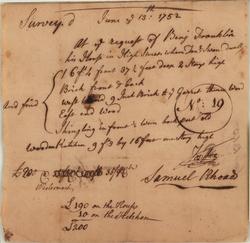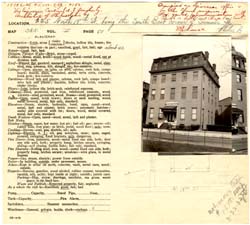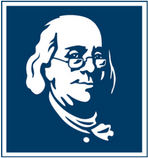|
The Philadelphia
Contributionship
Digital Archives
About the Company
About the Collection
Essays and Exhibits
|
About the Collection: Introduction

Account book of John C. Evans, Surveyor
On this page:
The Philadelphia Contributionship Archives, Insurance Surveys,
Surveyors
The Philadelphia Contributionship Archives
The archives of The Philadelphia Contributionship span the period
from 1752 until the present. They comprise roughly 300 linear feet
and consist of Minutes of the Board of Directors, Committee Minutes,
Treasurer’s Reports, ledgers, surveyors’ books and other underwriting registers.
In addition to these basic records are the correspondence files of
treasurers and directors as well as assorted miscellaneous files such
as publications, real estate, and as separate listings within this group,
volunteer fire companies and mutual fire insurance companies. The
company also maintains its canceled surveys and policies. Researchers
draw most heavily upon these latter files for details on individual
properties as well as more general information on the socio-economic
structure of the city in prior years.
Insurance Surveys
The early directors of The Philadelphia Contributionship adopted the
English custom of inspecting and appraising a property to determine its
value before accepting it for insurance. At the Board’s second meeting,
the directors appointed two of their own members, Joseph Fox and Samuel
Rhoads, as surveyors for the year, stipulating that at least one of them
survey each house proposed for insurance. The surveyor was to make
"a report in writing to the Clerk." These reports or surveys would then
be discussed by the entire Board at its next meeting, which would determine
the extent and rates of insurance. As compensation, the Board allowed
the surveyor 2 shillings and sixpence for "Surveying and reporting the
state of the Buildings to be Insured in one Policy."

Benjamin Franklin's Wine Store
1752 Survey
|

Archbishop's Residence, Philadelphia
1932 Survey
|
Early surveys contained a minimum of information: name of the owner
(and often the tenant), the location, dimensions, and number of stories,
building materials and a broad architectural description of the property.
As the directors' and surveyors' experience with losses grew the surveys
became somewhat more detailed. By the early nineteenth century the
surveyors began to list various rooms in the houses, methods of construction
and to describe in detail specific architectural features. Owners signed
the survey, attesting to its veracity. As years passed, sketches or maps
of the area often accompanied the surveys. The rise of photography in
the late nineteenth century added a new facet to surveys. Photographs
could show in detail those features, which were often so difficult to
describe, and by 1910 these were a standard part of every survey. The
twentieth century heralded in the era of standardized forms. Although
surveys had always followed a set format, now all the surveyor needed to
do in making his report was to list the dimensions, location, and underline
the appropriate features. Together with a photograph these forms provided
all the data needed to estimate the desirability of the risk, and the
rates and amount of insurance needed.
Surveyors
The Philadelphia Contributionship was fortunate in its first surveyors. Joseph Fox
and Samuel Rhoads were skilled master builders and would become future
presidents of the Carpenters' Company, one of America's most prominent building
guilds. Their successors were also members of the Carpenters' Company who,
in addition to serving on the Board of Directors of The Philadelphia Contributionship,
served the company on a free-lance basis. Besides surveying, they also assessed
fire damages, carved shields for fire marks, installed the marks and in
later years, handled fire repairs.
They kept accurate records of their surveys, filing loose records in one file
and (from 1768 forward) keeping a second set of these in bound ledgers or survey
books. They also kept separate account books, in which they listed the various
properties inspected, the amount owed and the fees collected. Separate memorandum
books list appointments, receipts of materials and repairs to properties.
Early surveyors included:
Joseph Fox & Samuel Rhoads
Although there was English precedent for surveying properties, Joseph Fox and
Samuel Rhoads presumably designed the format for The Philadelphia Contributionship surveys.
They worked together on the first ones as they assessed what was critical in
the information. Both came from strong building backgrounds. Born in 1709,
Joseph Fox was considered one of the city's most influential master builders,
a title also allotted to Samuel Rhoads, born a few years later. Their
paths crossed frequently; both were politically active and took a major role
in civic affairs. Their participation in the formation and operation of the
city's first insurance company was a natural role for each and they jointly
served as Surveyors for the first ten years of the Company's existence.
Joseph Fox, Surveyor 1752-1762, Director, 1752-1762; 1767-1779.
Samuel Rhoads, Surveyor 1752-1762; Director, 1752-1762.
Gunning Bedford, Surveyor 1762-1802; Director, 1762-1802.
Gunning Bedford was a loyal and stalwart Surveyor for The Philadelphia
Contributionship, beginning his association with the company at age 42 and
remaining affiliated until his death in 1802. Bedford, a well-respected
carpenter and builder, and influential member of The Carpenters' Company
provided the continuity in this key aspect of the company's operations as
he worked along side William Dillworth, Samuel Wetherill, Jr., Joseph
Rakestraw and David Evans.
William Dillworth, Surveyor 1762-1765; Director, 1762-1765.
William Dillworth (b. 1725, d. 1765), born in 1725 in Bristol Bucks County,
married Ann Wood in 1747. He, too, was a member of the Carpenters' Company
and is credited with the building of St. Paul's Church. John Logan also paid
him for his assistance in building his back porch. He was appointed a Surveyor
of The Philadelphia Contributionship in 1762 and elected to the Board. He died unexpectedly
at the age of 40.
Samuel Wetherill, Jr., Surveyor 1765-1778; Director 1765-1778.
Samuel Wetherill replaced William Dillworth as a Surveyor for The
Philadelphia Contributionship upon Dillworth's death in 1765. His election marked a major
change. While undoubtedly a skilled carpenter, he was not a member of the
Carpenters' Company, but instead was one of the organizers of the Friendship
Carpenters' Company in 1769, a rival company of young Philadelphia carpenters.
They issued their own price guide, one apparently at variance to that of the
Carpenters' Company of Philadelphia. Samuel Wetherill was one of a group of men
who framed the articles for the new company in 1769. He continued his survey
work for The Philadelphia Contributionship until he moved out of the province in 1778. His
removal was brief; in 1779 the Society of Friends disowned him for his role in
the Revolutionary War, and he returned to Philadelphia to found the Society of
Free Quakers in 1781. In the interim Wetherill had become a merchant, dealing
in cloths, and in later years, chemicals.
Joseph Rakestraw, Surveyor 1778-1794; Director, 1778-1794.
Joseph Rakestraw, the nephew of Joseph Fox, was elected a Surveyor in 1778
when Samuel Wetherill, Jr., moved out of the province. He was not unknown to
the company; as early as 1758 he began to make and erect the Company's fire
marks. He continued this practice after his election as Surveyor and it became
a part of the duties of the post, although he received an additional stipend
for each mark erected. His tasks in early years were light; no new policies were
written between August 21, 1778 and April 20, 1781, probably as a result of both
the war and currency problems. Business revived in the 1780s and Rakestraw
supplemented his income by doing some of the fire repairs himself. In addition
to his work for The Philadelphia Contributionship, Rakestraw did the State House repairs
in 1788 and helped with the construction of both the Library Company and the
President's House. Rakestraw continued to perform surveys for The Philadelphia Contributionship
until his death in 1794 from yellow fever.
David Evans, Surveyor 1794-1810; Director, 1794-1809.
David Evans took over the work of Joseph Rakestraw in 1794, serving as a
Surveyor with Gunning Bedford until Bedford died in 1802. The job of
affixing fire marks fell to Evans as well as supervision of the repair of
fire losses and procurement of materials. Evans also had a thriving career
as a builder: major works he built or supervised include Pennsylvania Hospital,
Fairhill, and City Hall. He frequently subcontracted The Philadelphia Contributionship's
work to others, including his son David Evans, Jr.. In 1804, Evans wrote of
recommending another distant relative and neighbor, John Evans, for repair work
and in 1809, at the age of 76, relinquished his position as surveyor to him.
John C. Evans, Surveyor 1809-1850; Director 1809-1819.
John C. Evans began his association with The Philadelphia Contributionship doing carpentry
repairs for fire losses in 1805. He was elected to the Board of Directors in
1806 and in 1809 replaced David Evans as the company surveyor. Evans' long-time
tenure as surveyor introduced a number of changes in the position. After 1819,
he no longer served on the Board of Directors, becoming instead a "free-lance"
Surveyor. He kept meticulous records, not only recording his surveys in books
(until 1837) but also keeping detailed account books, a practice he seems to
have begun in 1818. At that point he was to receive $3 for each survey made;
$6 if insurance was effected. The additional $3 paid for the attaching of a
fire mark and delivery of the policy. It may have been at this time that the
policyholder signed the survey as well, indicating that it was an accurate
description. Evans also noted on the survey if additional fees were to be paid
for travel expenses.
In 1836 Evans was requested to report to the office on a daily basis. The
use of badges or fire marks ceased around this time; subsequently Evans would
receive $3 for each survey when the property was accepted for insurance as well
as charges for all resurveys and surveys on non-insured properties. The Board,
however, guaranteed him $500 per year, an amount that rose through the years.
Surveys became more elaborate under his watch; as the Board recognized increased
risks to document. In 1839 the Directors required that the Surveyor include an
estimate of the probable value of the building to be insured along with the nature
of the adjoining building. In 1842 wallpaper was to be mentioned and in 1844 it
was agreed to cover the building and any fixtures in use, regardless of the purpose
of the building. It therefore became essential to list anything of importance in the
building including specific architectural and ornamental features.
John C. Evans died suddenly of a heart attack on June 9, 1850, at the age of 72.
The Board, shocked at the news gathered at a special meeting to appoint a new
Surveyor and record their sorrow at the death of their long-time colleague.
As a mark of their esteem they directed that the next quarter of his salary due
on June 24 be paid to his heirs along with an appropriation of up to $300 should
any member of the family be in need. That sum was later paid to his oldest daughter,
Mary Ann, and son, Morris.
Daniel R. Knight, Surveyor 1850-1868.
Daniel Knight (b. Circa 1797, d. 1871) was chosen to succeed John Evans, at a
salary of $900 per year. Like most of his predecessors, Knight was a respected
member of the Carpenters' Company (elected 1829), having served on the managing
committee for a number of years. From the beginning of his tenure at The
Philadelphia Contributionship the workload increased considerably, so much so that by 1852
the Directors raised his salary to $1200 per year. Prior to joining The
Philadelphia Contributionship, Knight pursued an active career as a carpenter and builder.
He lived on Cherry St, east of Ninth and erected a double row of buildings there
known as Knights' Court. Knight retired from his position in 1868 for reasons of
health and died in 1871. Fire insurance atlases were introduced during Knight's
tenure, detailed block by block maps of the city showing risk information of value
to property insurance companies including location descriptions, lot sizes
landmarks, fire protection and prevention systems and they became tools the
surveyors used heavily.
J. Louis Moore, Surveyor 1868-1889.
The last of the company surveyors with a Carpenter's Company connection,
J. Louis Moore began his survey work for the company in 1868. He was the first
to devote all of his time to The Philadelphia Contributionship and the Directors valued his
service. He reinstated the idea of survey books, recording in them abbreviated
surveys, some reports of fire losses, rebuilding costs, certificates of electricity
and specific risks. Moore's declining strength necessitated the hiring of an
assistant in 1885, and William W. Trapier was appointed. Trapier was responsible
for surveys and whatever else the Secretary entrusted to him. While Moore
retained the title of Surveyor, his duties were confined to whatever the Secretary
felt was important. Four years later, on January 31, 1889, a train struck and
killed Moore as he was walking on the tracks near Media Station. At the time of
his death, a note to the family of William Sellers advising them that Mr. Moore
was to make a survey of their house on Vine Street, was found in his pocket.
The Board directed that Moore's salary for the remainder of the year be paid
to his representatives and that an additional $250 be paid to his elderly sister,
Anna Moore, and $250 to his niece, Mary E. Robertson who also served as his housekeeper.
William W. Trapier, Surveyor 1889-1905.
William Trapier was elected Assistant Surveyor, working under J. Louis Moore,
in 1885, and upon Moore’s death in 1889, assumed the title of Surveyor. Trapier,
an engineer, brought his new skills to the task of surveying and the Board took
advantage of them. The survey now was to include the heating system, plate glass,
extra finish, decorations etc. Trapier often included floor plans in his
beautifully written surveys, which now extended through multiple pages.
He traveled farther afield to do his work, as more Philadelphians moved to
outlying areas. Bills for surveyors' carfare appear as incidental expenses
in these years.
Burton D. Blair, Surveyor 1905-1944.
Yale educated, with a degree in engineering, Burton D. Blair spent most of his
career at The Philadelphia Contributionship, beginning in 1902, as an assistant
to William Trapier. Despite serving an apprenticeship under Trapier, Blair soon
developed his own style, typing his surveys. In 1904 the company purchased a
camera from the Photographic Supply House and soon both men were incorporating
photographs into their surveys. Photographs provided sufficient detail that
the Company soon felt comfortable switching to a standardized form for surveys.
These forms contained much of the same information the surveyors were accustomed
to recording: construction and architectural features, information about heating,
lighting and cooling systems. All the Surveyor needed to do in making his report
was to list the dimensions and underline the appropriate items on the form.
They could also reference the insurance atlases,
which provided substantial information about not only the risk but also the
surrounding neighborhood. Blair was the first of the Surveyors to have a company car,
emblazoned with the symbol of the four clasped hands on the side. He retired in
1944 at the age of 75.
|

